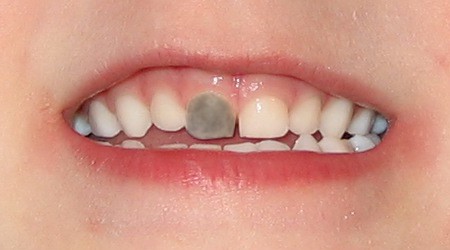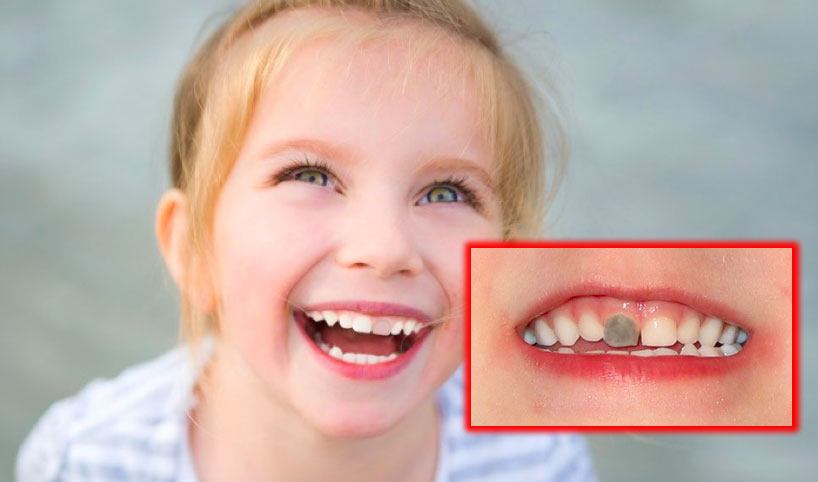Via Oral Answers
If you have kids, you know that they can get themselves into a lot of interesting accidents. Many times when kids get a head injury they knock out a tooth. Other times, they simply hit the tooth really hard and injure it.
It has been estimated that 8-30% of kids under 7 suffer an accident that injures one of their baby front teeth.
 Any time a tooth suffers an injury, there is a possibility that it may turn a different color. If you’re wondering what it means if your child’s tooth has turned pink, red, gray, black, brown, or yellow, then you’re the reason I wrote this article!
Any time a tooth suffers an injury, there is a possibility that it may turn a different color. If you’re wondering what it means if your child’s tooth has turned pink, red, gray, black, brown, or yellow, then you’re the reason I wrote this article!
Tip – I will use words like pulp, dentin, and enamel in this article. If you don’t know what those mean, you might want to brush up on The Anatomy of a Tooth.
When Your Child’s Tooth Turns Dark (Gray, Brown, or Black) After a Tooth Injury
When blood leaks out of blood vessels after a tooth injury, blood by-products such as iron can make their way into the small tubes inside the dentin layer of the tooth. As the blood breaks down, it can make the tooth appear to be gray, dark gray, brown or even black. This color change doesn’t usually occur until 2-3 weeks after the tooth has been injured and can occur after a tooth has turned red (see below.)
The book Paediatric Dentistry by Welbury states that “although the reaction is reversible to a degree, the crown of the injured tooth retains some of the discoloration for an indefinite period. In cases of this type, there is some chance that the pulp will retain its vitality, although the likelihood of vitality is apparently low in primary teeth with dark gray discoloration.”
Basically, the author is stating that even if a tooth has a dark color, it may still be able to return to health. Some experts have said that the darker the discoloration, the more likely it is that the nerve of the tooth has died. For example, this study “found that 33 of 51 traumatized teeth with gray-black discoloration were necrotic.” However, other experts state that the shade of darkness doesn’t reflect the health of the pulp.
If your child’s tooth has turned dark, the best thing to do is to have your child’s dentist look at it. If there are other signs that the tooth is dead such as swelling or an infection that shows up on the x-ray, then your child’s dentist will probably choose to do something about it such as performing a root canal treatment or removing the tooth.
If there is no sign of infection in a dark tooth, the dentist may choose to not do anything and let the tooth eventually fall out on its own when the permanent tooth is ready to take on its role in the mouth. A study by Sonis showed that 72% of darkened teeth fell out normally without any bad effects on the permanent tooth.
Also, if there are no other signs of infection, this study showed that there is no need to do a root canal. The researchers concluded that “Root canal treatment of primary incisors that had change their color into a dark-gray hue following trauma with no other clinical or radiographic symptom is not necessary as it does not result in better outcomes in the primary teeth and their permanent successors.”
When Your Child’s Tooth Turns Red or Pink After a Tooth Injury
If a tooth is going to turn red after an injury it can turn red shortly after the injury, or it can wait anywhere from a few weeks to months before it begins to turn a pinkish red color.
Red and Pink Teeth Immediately After the Injury
If a tooth turns red shortly after being traumatized, it usually means that the blood vessels inside the pulp broke. When the blood vessels rupture, blood leaks inside the whole pulp area of the tooth resulting in a reddish pink color. This condition is known as pulpal hyperemia.
Sometimes pulpal hyperemia is difficult to detect. You may have to shine a light on your child’s tooth and look at the tongue side of the tooth with a mirror to detect this color change.
The pink/red color may take a long time to go away or it may never go away and the tooth may start to darken to a shade of gray.
Red and Pink Teeth Weeks after the Injury
As a result of trauma, sometimes cells inside the tooth start eating away at the hard layers of the tooth through a process called internal resorption. These cells are calledodontoclasts and in certain cases they can eat away to the outside of the tooth within a few short weeks. The tooth looks pink because as the pulp layer of the tooth gets bigger, its red color more easily shines through the thin layer of remaining tooth structure.
A man named James Howard Mummery first noticed this “pink spot” that appears on teeth, which is why it is typically referred to as pink tooth of Mummery. Pink tooth of Mummery can start occurring anywhere from a few weeks to months after a tooth is injured.
These teeth are usually kept until the crown of the tooth is dissolved. Then the tooth root can either be removed or it can be left to get dissolved spontaneously as the permanent tooth comes into your child’s mouth.
When Your Child’s Tooth Turns Yellow After a Tooth Injury
The dentin layer of a tooth under the enamel is normally a yellow color. If a tooth reacts to an injury by laying down a lot more dentin, it is known as pulp canal obliteration (Also called calcific metamorphososis, progressive canal calcification or dystrophic calcification.)
The increase in the amount of dentin and the concurrent decrease in the amount of pulp gives the tooth a yellow, opaque color.
The book Pediatric Dentistry by Pinkham states that “although pulp canal obliteration is a pathologic process, it has no known deleterious effects and therefore does not necessitate any treatment except follow-up.”
It is important to regularly follow-up with your child’s dentist about any teeth that have turned yellow after an injury. The book Paediatric Dentistry by Welbury notes that “a small percentage [of yellow teeth] demonstrate pathologic change many years after the injury.”
Conclusion
Many times parents want to rush treatment when their child’s tooth changes color. It is important to understand that “in the primary dentition of a healthy child, color change alone does not indicate a need for pulp therapy or extraction of the tooth (Pinkham.)”
Basically, if your child’s baby tooth has changed color, often the best treatment is no treatment. As long as an infection doesn’t develop, simply waiting it out and seeing what happens could mean that your child doesn’t have to go through unnecessary dental treatment. And that’s a good thing, especially after they’ve already been through a traumatic tooth injury.
Source: Oral Answers
